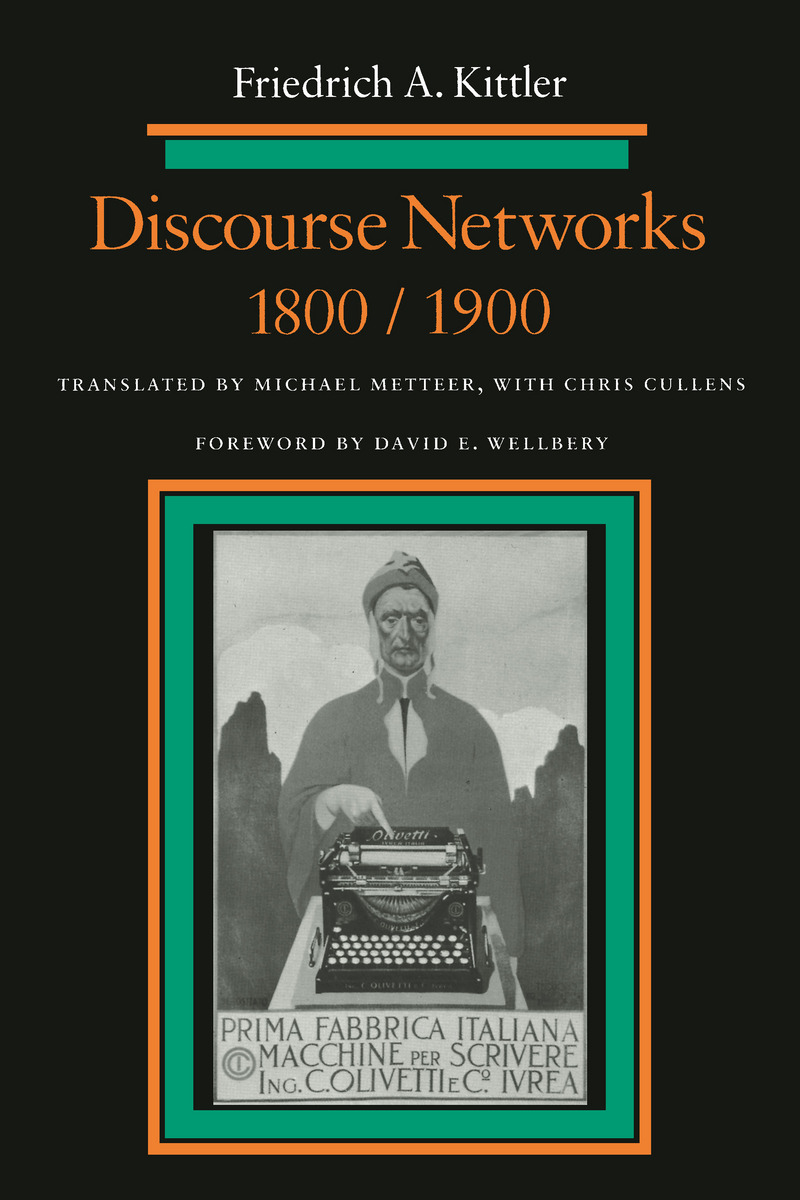Friedrich A. Kittler: Discourse Networks 1800/1900 (1985–) [German, English]
Filed under book | Tags: · communication, discourse, history of literature, language, literary theory, literature, media, media archeology, media technology, media theory, philosophy, psychoanalysis, psychophysics, technology, writing

“This is a highly original book about the connections between historical moment, social structure, technology, communication systems, and what is said and thought using these systems–notably literature. Friedrich Kittler focuses on the differences between ‘discourse networks’ in 1800 and in 1900, in the process developing a new analysis of the shift from romanticism to modernism. The artful structure of the book begins with Goethe’s Faust and ends with Valéry’s Faust. In the 1800 section, the author discusses how language was learned, the emergence of the modern university, the associated beginning of the interpretation of contemporary literature, and the canonization of literature. Among the writers and works Kittler analyzes in addition to Goethe’s Faust are Schlegel, Hegel, E.T.A. Hoffman’s The Golden Pot, and Goethe’s Tasso. The 1900 section argues that the new discourse network in which literature is situated in the modern period is characterized by new technological media–film, the photograph, and the typewritten page–and the crisis that these caused for literary production. Along the way, the author discusses the work of Nietzsche, Gertrude Stein, Mallarmé, Bram Stroker, the Surrealists, Rilke, Kafka, and Freud, among others.”
Aufschreibesysteme 1800/1900
First published in 1985
Third, completely revised edition
Publisher Wilhelm Fink Verlag, Munich, 1995
ISBN 3770528816, 9783770528813
524 pages
Discourse Networks, 1800/1900
Translated by Michael Metteer, with Chris Cullens
Foreword by David E. Wellbery
Publisher Stanford University Press, 1990
ISBN 9780804720991
496 pages
Reviews: Franz Futterknecht and David Wellbery (Poetics Today, 1987, EN), Robert C. Holub (German Quarterly, 1987, EN), Thomas Sebastian (MLN, 1990, EN).
Wikipedia (DE)
Publisher (DE)
Publisher (EN)
Aufschreibesysteme 1800/1900 (German, 3rd ed., 1985/1995, removed on 2024-2-6 upon request from Brill)
Discourse Networks, 1800/1900 (English, 1990, updated to the full book on 2014-1-30 via poshumano, updated to single-page OCR’d version on 2014-1-31 via Marcell Mars)
Online version of Index of persons (at Monoskop wiki)
Comments (3)Richard Burt (ed.): The Administration of Aesthetics. Censorship, Political Criticism, and the Public Sphere (1994)
Filed under book | Tags: · aesthetics, censorship, cyberpunk, degenerate art, discourse, literary criticism, postmodernism

The “new” censorship of the arts, some cultural critics say, is just one more item on the “new” Right’s agenda, and is part and parcel of attempts to regulate sexuality, curtail female reproductive rights, deny civil rights to gays and lesbians, and privatize public institutions. Although they do not contest this assessment, the writers gathered here expose crucial difficulties in using censorship, old and new, as a tool for cultural criticism.
Focusing on historical moments ranging from early modern Europe to the postmodern United States, and covering a variety of media from books and paintings to film and photography, their essays seek a deeper understanding of what “censorship,” “criticism,” and the “public sphere” really mean.
Getting rid of the censor, the contributors suggest, does not eliminate the problem of censorship. In varied but complementary ways, they view censorship as something more than a negative, unified institutional practice used to repress certain discourses. Instead, the authors contend that censorship actually legitimates discourses-not only by allowing them to circulate but by staging their circulation as performances through which “good” and “bad” discourses are differentiated and opposed.
These essays move discussions of censorship out of the present discourse of diversity into what might be called a discourse of legitimation. In doing so, they open up the possibility of realignments between those who are disenchanted with both stereotypical right-wing criticisms of political critics and aesthetics and stereotypical left-wing defenses.
Publisher U of Minnesota Press, 1994
ISBN 0816623678, 9780816623679
Length 381 pages
More info (publisher)
More info (google books)
PDF (no OCR; some pages missing)
Comment (0)
